Calavera and Day of the Dead Desserts
The gorgeously adorned calavera is an emblem of the celebrations of the Mexican Día de Los Muertos that are recognised worldwide. Even people celebrating other Day of the Dead festivities, like Halloween, are enchanted! How could you not be?
Like many of the desserts and traditions in these holidays, these skulls hold an incredible amount of significance in Mexico’s culture, cuisine, history, and art. Let’s discover some of the stories behind the iconic sugar skulls, as well as other delicious desserts offered to the dead around the world!

Beautifully adorned calavera sugar skull with the name Catrina (referring to the iconic lithograph by illustrator, José Guadalupe Posada)
Calavera for Día de Los Muertos (Mexico)
The word “calavera” actually translates to “skull” from Spanish and can be used for any artistic rendering of a human skull, including lithography, paintings, and most commonly, the beautifully adorned sugar skulls. Skulls and skeletons hold a lot of significance in many cultures. For Mexico, they represent both death and rebirth.
The history of calaveras is believed to have come from when the Spanish invaded Anahuac (which was the name the Indigenous Nahuas Peoples called Mexico), and attempted to alter the Nahuas’ beliefs and rituals. The use of actual human skulls was replaced with representations which were made from sugar, a resource the land began to develop a surplus of. The sugar also represents the sweetness of life, and is adorned with beautiful decor such as foil, icing, sequins, and even feathers. As each skull represents a person who passed away, the bright decor is meant to signify the beauty and brightness of their life. When used in the ofrenda, or “offering,” the sugar skulls are not necessarily eaten, as some of their decorations include inedible adornments. But the popularity of these candies has definitely risen throughout the years.
They’re widely used in funeral rites as well as for the Mexican celebration of Día de Muertos. It is really meant to be a celebration, not a dark or macabre time. There’s much love and remembrance that takes place and skulls, mostly the ones made of sugar, are placed on the altars or gravestones.
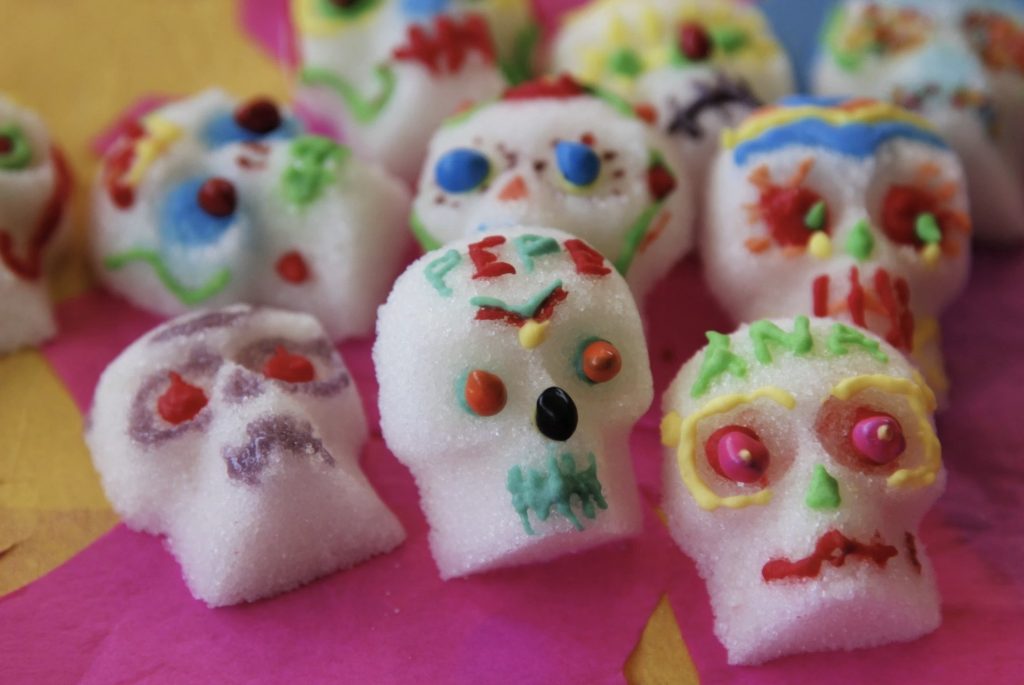
Homemade and hand-decorated sugar skulls (Mama Latina Tips)
Although it seems to insinuate only one day, Día de Los Muertos actually takes place over the course of two days. November 1st is dedicated to the souls of children who have passed away, and November 2nd is more of a colourful celebration for the lives of adults who have died. This holiday holds a special cultural significance for the people of Mexico and Mexican descent where they connect with their ancestors.
Day of the Dead Desserts Around the World
Guaguas de Pan or T’anta Wawas for Dia de Los Difuntos (Ecuador)
In Ecuador, Day of the Dead is called Dia de Los Difuntos. Like Día de Los Muertos, it’s split into two days. November 1st is a smaller event that commemorates the children and is called El Día de Todos los Santos. November 2nd is the more boisterous celebration with food and drink that celebrates the lives of adults. Guaguas de Pan (or T’anta Wawas in the Indigenous language to Ecuador, Quechua) is a very beloved bread in these celebrations in the Andean region (Peru, Ecuador, Bolivia, Colombia and Northern Argentina). It’s baked into the shape of a baby and actually directly translates to “bread babies” in both languages. They are usually made of wheat and sometimes contain a sweet filling. Similarly to the calavera, once they’re made, they’re then adorned with bright icing and colourful decorations. During the Days of the Dead, these meaningful sweet treats are given to loved ones, either in-person or left on graves.
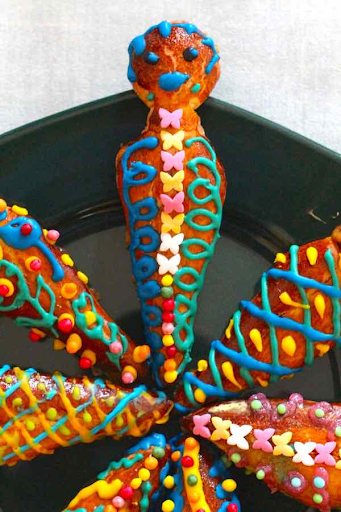
Ecuadorian Guaguas de Pan (196 Flavors)
Qingtuan for The Qingming Festival (China)
Unlike most Days of the Dead, the Qingming Festival happens closer to the Spring Equinox in April. It’s a time when friends and family gather at the final resting place of loved ones to remember together. This is also the time of year when sweeping maintenance to the graves is encouraged. It’s filled with much love, positivity, respect, and of course, delicious food. It’s certainly tradition to eat and bring the foods that the person of honour loved in life, but there is also a special food called Qingtuan that people enjoy at this time of year. Qingtuan is a mugwort (green grass weed) dumpling filled with sweet red or black bean paste that traditionally was only available when mugwort became edible in the early spring. The mugwort gives the dumpling a green color and it was mostly enjoyed during the festival that Qingming evolved from, which was called the Cold Food Festival. Nowadays, these dumplings can get their green colour by mixing matcha into the glutinous rice flour instead of the mugwort. Modern bakeries also started offering new creative filling ideas such as salted egg yolk, cashew nuts, and dried meat floss.
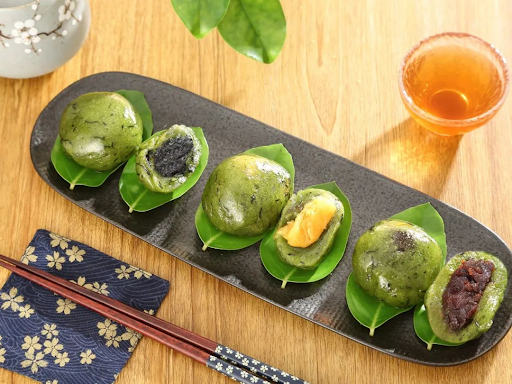
Green Qingtuan dumplings (The China Project)
Png kueh for The Zhongyuan Festival (Eastern Asia)
The Zhongyuan Festival, also known as the Hungry Ghost Festival is in many ways similar to the Qingming Festival. However, it is different in that it’s the day where the gates of Hell are opened. Hungry Ghosts are a concept in Buddhism that represent people who have either died in violent ways, were violent in life, or were neglected by their descendants after death. It’s said that on this day, these ghosts come back to Earth seeking entertainment, food, and recognition. There’s often a huge celebration of feasts and concerts to entertain these Hungry Ghosts. This festival is held in a few East Asian countries including Taiwan, Japan, Indonesia, Singapore, and Malaysia.
Png kueh is a popular dumpling eaten during this time and in each region it may look a bit different. Contrasting the green of the Qingtuan dumpling, it is bright pink and filled with glutinous rice, mushroom, fried shallots, and sometimes dried shrimp flavour. It’s shaped like a peach hence its name, which means “peach dumplings”. In the past, peaches were used in religious offerings as a symbol of longevity. As peaches are only available once a year, dumplings like the Png Kueh were made in the shape and hue of out of season peaches offerings. Their origin comes from the Teochews culture (South-East Asia) and the dumplings are called Poong Tor (meaning: rice peaches).
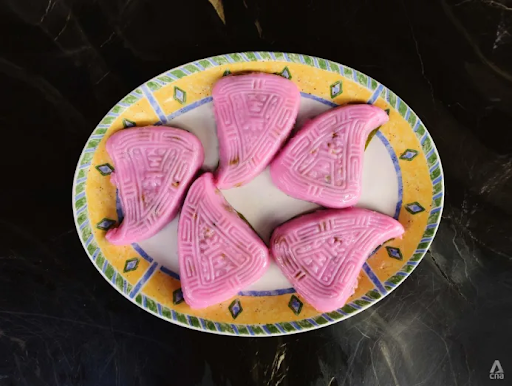
Madam Joo’s Teochew png kueh (CNA/Joyee Koo)
Huesos de Santo for Día de Todos Los Santos (Spain)
All Saint’s Day, or All Hallow’s Day is more of a somber celebration than most on our list. It’s a Catholic holiday celebrated around the world on November 1st. Its traditions have influenced many celebrations of Day of the Dead, including Halloween, which we go further into in our blog on candy types. Many ancient rituals involving the commemoration of the deceased have persevered through colonization and in some cases melded with this holiday. It’s meant to celebrate Saints, but through the years has become a celebration of the Dead.
In Spain, Día de Todos Los Santos is a national holiday and is recognized as a time to visit cemeteries with loved ones. One of the main treats enjoyed on Día de Todos Los Santos is Huesos de Santo. These marzipan-based desserts translate to English as “Saint’s Bone” and are meant to resemble a bone with marrow in the centre. The marrow is a yolk jam, thankfully. It’s believed that the Spanish influence between the 16th and the 18th centuries resulted in a few variants such as the Mexican calaveritas de dulce and pan de muerto.
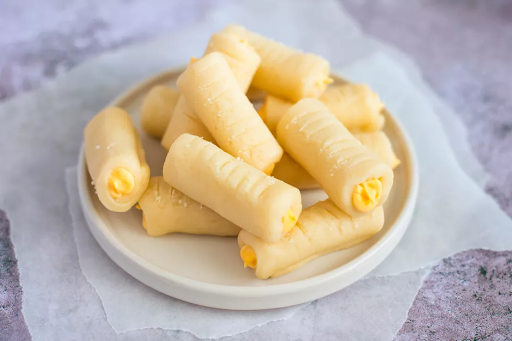
Saint’s Bones – Huesos de Santo (The Spruce Eats/Julia Hartbeck)
Songpyeon for Chuseok (Korea)
This three day festival is celebrated in both North and South Korea. In North Korea, it’s only celebrated for one day, and in South Korea, it’s one of the biggest traditional holidays, and honours the full three days. Chuseok is a holiday when many people return home to their families, sharing good food and traditionally, celebrating the harvest season. It’s similar to North American Thanksgiving in some ways, except there is an intentional appreciation of ancestors and passed loved ones. Similarly to the Qingming Festival, the family time also includes a visit to the cemetery to tend to grave sites and to remember those who have died. Eating Songpyeon is very popular during this festival. They are half-moon rice cakes that are steamed on a bed of pine needles, which gives them a very distinct taste. They have a huge variety of fillings including honey, chestnuts, and red beans. Because Chuseok is a time of both harvest and deceased family, Songpyeon was made as a sort of fresh rice harvest sacrifice to give to loved ones.
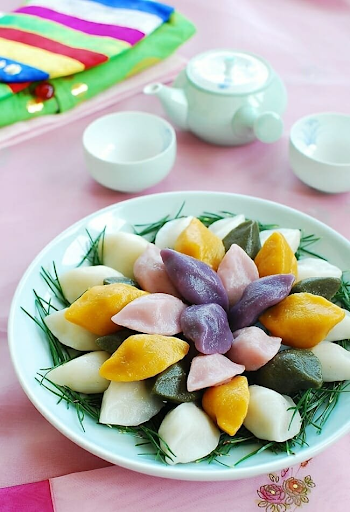
Songpyeon – half-moon shaped rice cakes (Korean Bapsang)
Ayote en Dulce for La Calabiuza (El Salvador)
La Calabiuza has re-emerged as a passionate way of celebrating both lost loved ones and the pre-colonial history of El Salvador. For the celebration, residents dress up as traditional figures in folklore such as El Cipitío and La Llorona. They then make a trekk from their local cemetery to the downtown core. Calabiuza means “skull” and it’s increasingly becoming a way for especially the youth of El Salvador to reject Halloween and instead connect with the traditions of their own history. Throughout the years, a dessert of ayote en dulce has become deeply associated with this celebration. It’s a dessert of a gourd (climbing vine plants bearing fruits such as pumpkins, squash, melons and cucumbers) usually roasted in honey, as a traditional harvest treat.
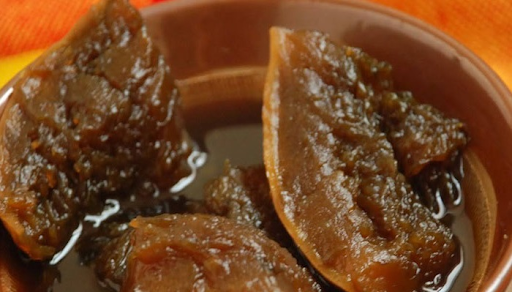
Ayote en Dulce or Ayote en Miel (Transdoc)
Num Ansom for Pchum Ben (Cambodia)
The fifteen days religious festival of Pchum Ben in Cambodia takes place midway through the tenth month in the Khmer calendar, which is about the end of September or beginning of October. It’s a time to honour the previous seven generations of family that have passed on and it’s believed that they all return to Earth for the time of this festival. Because the return is accompanied by the opening of the gates of Hell, Buddhist monks chant suttas tirelessly at the pagoda (Buddhist temple). Pchum means “a gathering of people” and ben means “a ball of something,” usually food. Offers of food are abundant during Pchum Ben, and it’s very popular to give banana leaf-wrapped steamed rice balls/rolls (Num Ansom) as sacrifice and to the meditating monks. Num Ansom is usually filled with bananas, jackfruits or pork and is also a common sticky rice cake that is part of the celebration of the Khmer New Year.
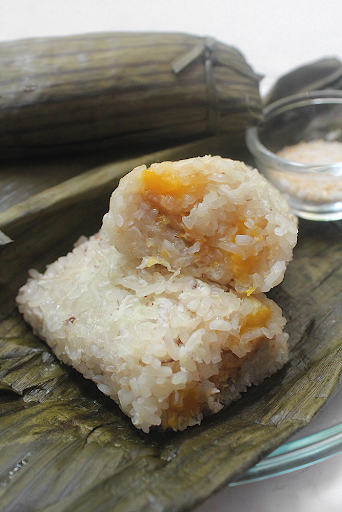
Num Ansom – Cambodian sticky rice cakes (Amcarmen’s Kitchen)
Biko for Araw ng mga Patay or Undas (The Philippines)
This holiday translates from Tagalog to English as “Day of Those Who Have Passed Away.” Like many celebrations of the dead, it’s both a religious and cultural celebration. It’s a November 1st festival where ceremonies and remembrance are everywhere. People will return to their family homes to spend time with the living and also visit their deceased family members to clean and maintain their grave markers. A very popular dessert is biko, which is a sticky rice cake. We go into more detail about it in our Filippino Desserts blog. This dessert comes from an old souling tradition from the Philippines called Pangangaluluwa. It was held on October 31st and children would dress up in sheets to resemble ghosts. They would sing and go from house to house asking for treats! Biko was the traditional treat given during this tradition.
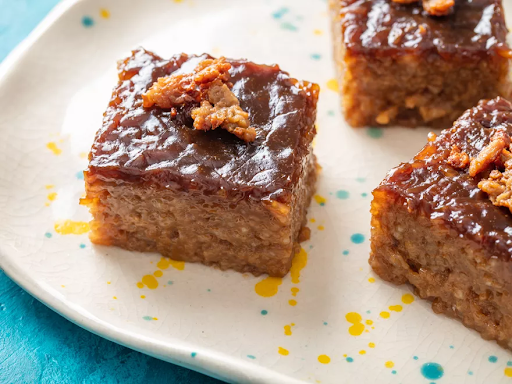
Biko – Filipino Sticky Rice Cake (Serious Eats/Vicky Wasik)
Sel roti for Gai Jatra (Nepal)
Gai Jatra is a Day of the Dead celebration that has adapted into something very unique throughout the years. It’s held in the Bhadra in the Bikram Sambat calendar, which moves from August into September, and it actually takes place over the course of eight days. It’s a celebration with parades and children who dress as cows, and it’s meant to bring joy into the somber process of mourning. Why do they dress as cows? In Nepalese tradition, it’s believed that cows guide the deceased’s soul into their next life.
Although it’s fundamentally a time for grieving families, what makes it unique is that it has become a period of governmental protest as well. This tradition began with King Pratap Malla (17th century) who lost his son and went through an intensive grieving process that resulted in him creating a parade for all families who have lost loved ones to march in. When he saw how many people attended, he decided to hold it as a day of equality as well, where humanity was upheld over hierarchy. It’s since become a time of joyous celebration of the lives of the deceased, as well as a joke-filled farce of political sarcasm and protest.
While there is no official food that is associated with the festivities, each family prepares a feast with popular Nepalese food such as momo dumplings, pilaf rice, thukpa soup, and sel roti bread. We will focus on a Nepalese favourite sweet, sel roti, a sweet doughnut deep-fried in oil or ghee and made with rice flour.

Sel roti – Napalese sweet bread (The Weekender)
Shoryo Uma for Obon (Japan)
Depending on the calendar used, Obon is at three different times of the year, and sometimes, they even intersect. For the areas that follow the Gregorian calendar, this festival takes place around the 15th of August. Obon is three days long and cares for the spirits of ancestors who return to the land of the living. There are many ways to celebrate and acknowledge Obon, and often it’s with fire and dance. Kyoto has one of the most iconic bonfires that forms the character 大, which is pronounced “dai”, and means “great” or “big.” Many places perform Bon Odori as well, which means “bon dance.” This dance is meant to welcome the spirits of the dead and as it’s very culturally influenced, it varies from region to region.
Like many Days of the Dead, the main food or dessert enjoyed are the ones the deceased family members loved most. One that’s shared by many regions and families across Japan is the shoryo uma. These are made with a cucumber (that represents a horse) and an eggplant (that represents a cow) with chopsticks or matchsticks as legs. Shoryo uma means “spectral horse” and they’re not so much eaten as they are left for the deceased family members and ancestors to ride. The souls dash in quickly on the horse, following a line of smoke left from their family’s incense. And when the festivities are over, they leave slowly and solemnly on the cow, looking forward to the next year. Unlike festivals like Halloween, the returning souls are not considered frightening, but are welcomed.
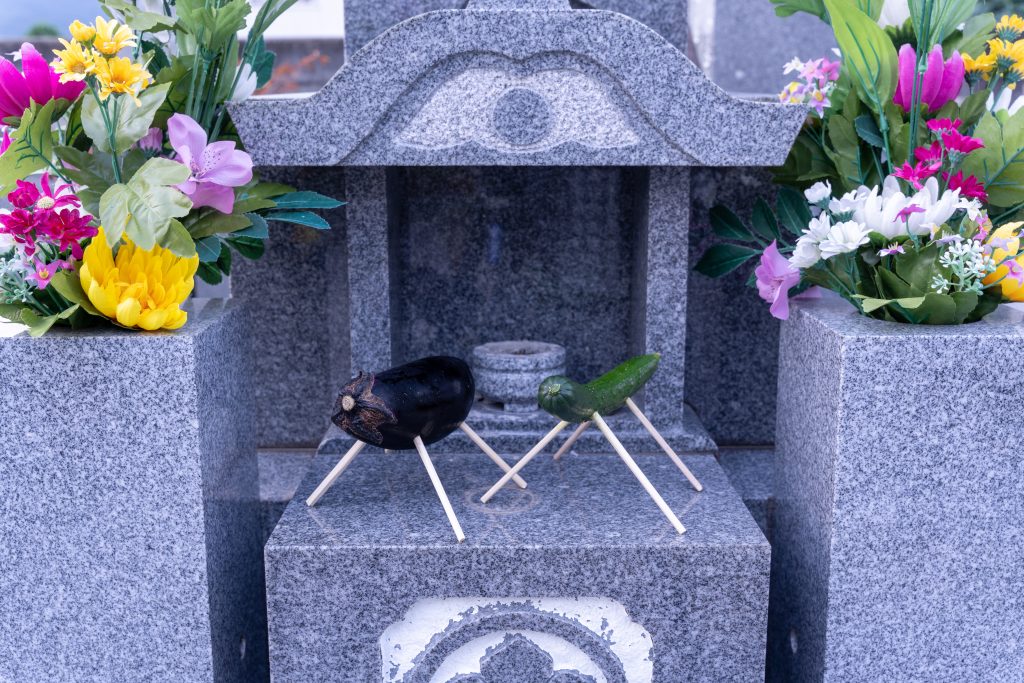
The cow and horse shoryo uma
Pinda Dana for Pitru Paksha
Pitru Paksha is a sixteen day period when people who follow Hindu faith pay reverence to their deceased family members. In Hinduism, when someone passes away, they enter the Pitra Loka which is the realm of ancestors, looked over by the deity of death, Yama. The stage after Pitra Loka is Moksha, which is the realm where a soul detaches from human existence and moves beyond life and death to be with Vishna. Pitru Paksha specifically pays homage to souls in Pitra Loka, so usually it honours the previous three generations. The anniversary of a loved ones’ death is celebrated looking at the moment in the lunar cycle as opposed to the date on a calendar. Whatever day of the sixteen Pitru Paksha days coincides with that lunar day is when the male of a family performs Saddha (a ritual honouring the dead). This ritual involves pinda dana, which is a ball of cooked rice. This is often mixed with black sesame seeds and ghee. Pinda dana is used in this ritual, as well as in funeral rites.

Preparation of the Pinda Dana (Times Now News)
Festival de Barriletes (Guatemala)
Also known as the Giant Kite Festival, Festival de Barriletes is a colourful and gorgeous celebration filled with kites in Guatemala. It takes place over the course of three days at the beginning of November. This tradition of flying kites for their Day of the Dead dates back to pre-Columbian times and represents the union of the land of the living with the land of the dead. The kites were used as beacons for the dead to find their loved one. So, these gorgeous creations are designed and made throughout the year with great care and pride. Some of them can be even forty feet in diameter! Many people celebrate this festival with its original purpose and will fly the kite above the grave of a loved one with a tied message meant for them. But it’s also become a huge festival independent of its origins, simply a celebration of kite artistry and cultural appreciation.
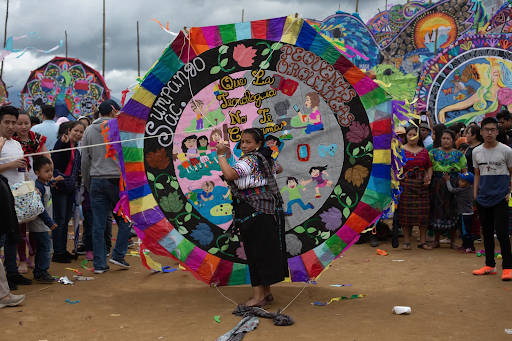
Sara Xicon launches the kite for her group, Las Orquideas, the first all-female kite group in Guatemala (Vogue)
Similar to la Calabiuza in El Salvador mentioned above, Guatemalans prepare ayote en dulce or ayote en miel, a delicious squash cooked in a sweet syrup of panela (unrefined cane sugar) and spices. This dessert is popular among many Central American countries like El Salvador, Honduras, and Nicaragua.
Death can be an overwhelming concept to struggle with, and it’s something that every human or creature has in common. These rituals and desserts bring people an immense amount of comfort in some of the most incomprehensible moments of grief. And they’re so often done, not with a heaviness, but in a burst of celebration, colour, and expression of joy. Day of the Dead, whether that be Día de Los Muertos, the Zhongyuan Festival, or even Halloween serve as a beautiful reminder that people will be remembered and loved even in death. So have your biko, saint’s bones, and calavera, and enjoy your festival of the dead!




